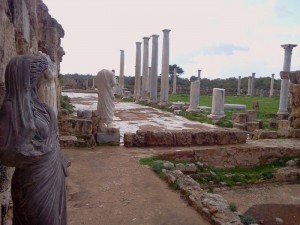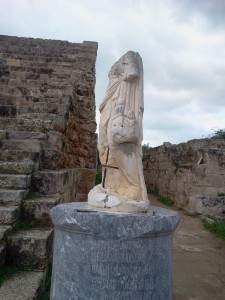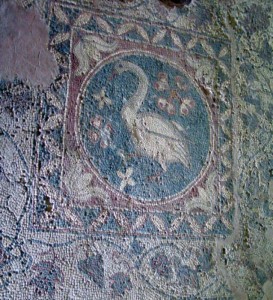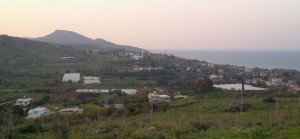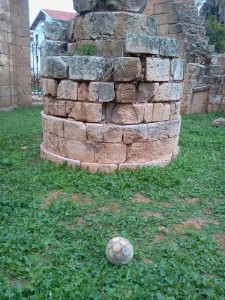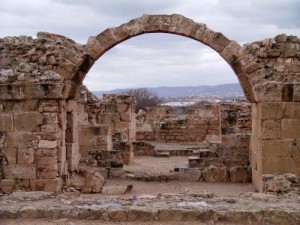As my travel companion Ugnė wrote (in Lithuanian), Cyprus is rich in well-preserved and accessible ruins, particularly in Famagusta, which she calls the capital of antique ruins. As I wrote in my earlier blog post, people interact with objects in a very direct and laid-back way. Sterility of museums seems to be alien to the local culture. There are museums, of course, but even in them visitors can come closer and interact with objects more directly.
Salamis, North Cyprus
Probably the most amazing ruin site is Salamis, the ancient capital of Cyprus (near Famagusta). Visitors pay €9 to enter, but a student card can make the price shrink to €2, and there is a ticket office only at the front entrance. We saw people using alternative ways in and out. A local in Famagusta told us that people liked visiting Salamis for picnics. Blogger Kate Trenery, whose travel stories I read while preparing for the trip, also noticed women bringing flowers as an offering. As we walked around, taking photos of the ruins, we met two dogs and several cats roaming around. It is reassuring to see that the ancient structures, built to be used as houses, gyms and streets, were still in use rather than being turned into a touristic disneyland.
Archeologists have discovered traces of a necropolis and a port dating back to the 11th century BC. This trading center used to belong to Alexander the Great and Ptolemy of Egypt, but most of the surviving ruins are from the subsequent Hellenistic and Roman eras. It was rebuilt after a major earthquake by the Byzantine emperor Constantius II (4th century), but then abandoned in favor of what is now Famagusta when pirate raids devastated the city.Probably the most impressive part of the ruins is the ancient exercising ground (1st century AD), with some remaining walls of baths, swimming pools and latrines. There is a surviving fresco from the 3rd century, and mosaics of the legends of the murder of Niobe’s children and of Leda disguised as a swan. We noticed that many of our CS hosts worked out to get in shape or lose weight, and it was funny to see that working out has really long traditions in Cyprus.
There is also a theater, which used to have a capacity of 15,000 spectators. Now a lonely sculpture, which used to decorate its stage, holds a mask , which proved to be more resilient than her face.
We spent three hours wandering around the Y-shaped field with the ruins, but we could have spent more if we had taken food with us. There are remnants of a Roman villa, an olive press, an agora and shop counters, as well as buildings of two cults – two Christian basilicas and a temple of Zeus. It is also interesting to observe the water pipes and stone remnants of a water reservoir – of course the wooden parts have been missing for centuries. I overheard someone explaining in German about the reservoir, which worked as a rather precise water clock and calendar, so I asked the group if I could listen, and got a detailed explanation of the system.
Soli, North Cyprus
The ruins of Soli are situated near the town of Lefke. Entrance is €4 regular fare, €2 a discount ticket. The age of the first settlement is similar to Salamis – dated 11th century BC. It became an important Christian Orthodox religious center, so one ancient church (one of the oldest in Cyprus) with tombs was soon replaced by a 4th century AD basilica, and the latter was replaced with a 6th century basilica. Explanatory notes indicate which basilica a specific object belonged to. The ruins are famous for their surviving mosaics, including the iconic swan.
We saw one of the funniest signs in this area – visitors are asked not to pour water on the mosaics. Why would it occur to someone to pour water on them? Perhaps some people thought they could get brighter colors for photos this way.
Explanatory notes suggest that one of the naves of the church was decorated with less elaborate patterns and hence it was most probably used by women, children and people still waiting for their baptism. I hadn′t known that ancient churches had that separation.
There is also a theater, like in Salamis, which looks, on the onset, too well preserved. The booklet we got tells the secret – it was reconstructed in the 19th century. The theater was originally built in the 2nd century AD. There is also a less impressive agora and palace ruins in the area, but like in many other ruins, there is very little signage to follow, which encouraged us to look for unbeaten paths around the area. We climbed on top of the theater seats and found that there was a place where the fence, surrounding the ruins, was broken. Soon we found ourselves on a beautiful green hill with a stone field, overlooking an orange farm. We climbed the hill further and waited until the sun sets on a beautiful valley with cute houses, goats and farms. A group of locals climbed the hill from the other side to watch the sunset.
Famagusta Old Town, North Cyprus
In the Middle Ages Famagusta used to be an important stop of the Silk Road. Its past, when the town was famous for its many churches, got a new direction during the Ottoman rule (since the second half of the 16th century). The main cathedral, late Gothic in style, was transformed into a mosque. Some other churches are now historical ruins, where people can climb everywhere and take photos. The former churches of St. Francis and St. George of the Greeks are very close to the mosque that used to be a cathedral. The former seems to be used as an outdoor cafe in summer, but when we went there, a pleasant smell of freshly cut grass surrounded its tranquility.
Kato Paphos, South Cyprus
The main tourist attraction inside Paphos is the Tombs of the Kings. There are many touristic places just outside Paphos, but they may be difficult to access with the unreliable public transport, and those who would consider renting a car may be discouraged from doing so if they are not used to driving on the left side. Still, Kato Paphos, or Old Paphos, is rich in historical ruins and mosaics to keep one busy for a few hours, and it is also on UNESCO list. The ruins are close to the elegant white lighthouse of Paphos. There is a revolving door, but nearly no signage from the outside.
There main highlights of the complex are the ancient houses of Dionysos, Theseus and Aion. The floor mosaics are from the 4th to 2nd century BC. The House of Theseus doesn’t even have a roof.
Paphos, which is also one of the two Ryanair airports in Cyprus, will be the European Capital of Culture in 2017.


![Cats of antiquity [click on the images to enlarge them]](http://www.daivarepeckaite.com/wp-content/uploads/2015/01/cyprus07-225x300.jpg)
